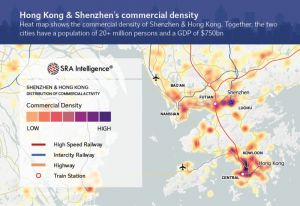
In his latest geospatial analysis he shares with PBEC his thoughts on the perceived growing rivalry between Hong Kong and Shenzhen.
“There’s a lot of talk about competition between #shenzhen and #hongkong. But collaboration is the path forward. The two cities both have vibrant private sectors that are already finding synergies, leaving policy making to catch-up. Seeing the two cities as a combined opportunity is inevitable at the boardroom level. We’ve put together a commercial density map to indicate how activity is distributed across Shenzhen and Hong Kong’s combined $750+ billion GDP. Shenzhen’s advanced manufacturing and #technology sectors leave the city well positioned to profit from a fast-changing global economy. Hong Kong’s international DNA is not easily replaceable and will play a key role for Shenzhen-based firms (and other GBA firms) as they internationalise. As a leading services hub, Hong Kong is already helping Shenzhen firms manage supply chain disruption and allocate new investments into Southeast Asia.”
Ben was happy to provide an exclusive executive briefing to PBEC HK members back in early October on China’s growth prospects. Business conditions vary widely by city and sector across China during its recovery phase. Today’s travel restrictions, fast-changing business landscape, and increasingly important Tier 2 and Tier 3 cities, make insightful analytics and digital solutions more important than ever. SRA Intelligence geospatial analytics enables multinationals and senior executives to recalibrate strategies across multiple geographies. That’s part of the power and influence of PBEC.

